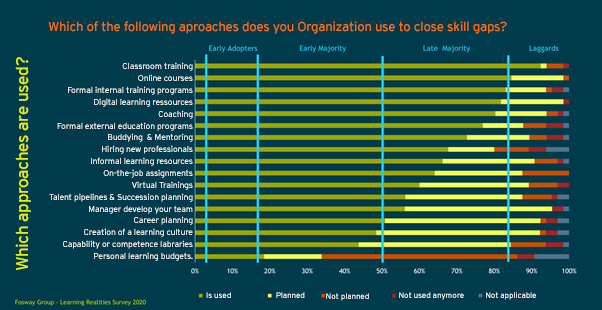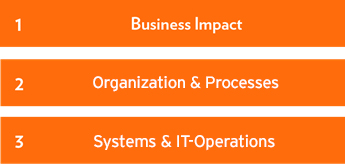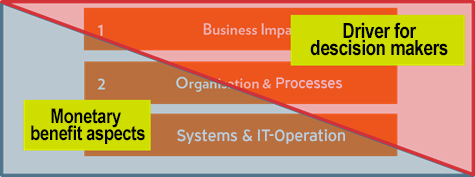In the current Covid-19 pandemic, digital learning is getting a massive boost. It was not long ago – early February 2020 to be exact – that 90% of European companies saw significant skills gaps in their organization, and 79% considered the development of new skills a high priority.1
At the moment, however, many companies are feeling the pressure to operate efficiently, cut costs, and step up their efforts to defend their cash flow position. So, it is only natural to hit the pause button on major investments and, in principle, spending on corporate training is no exception to the rule. In the context of this discussion, some CFOs sometimes point to the current surplus supply in the labor market. And while there may indeed be some short-term, temporary reliefs for some jobs, skills shortages and skills gaps will not vanish. Because once the economy stabilizes and starts growing again in the coming months, the overarching trends will resurface.
In response to the Covid-19 lockdown, a large number of organizations have increased their spending on digital learning, particularly in the areas of content, learning platforms and digital learning services². The Fosway Group study also showed: top management requests digital learning with 82% recognizing the value digital learning can currently bring to their organization. Moreover, 10% of the companies surveyed even claimed that they had immediately gone through a procurement process in response to the pandemic to improve the use of digital learning within the company³.
Of course, there is no question that digital learning in this context needs to be so much more than just digital content. Collaborative working and learning, coaching, feedback and reflection must be encouraged to help staff cope with the seismic changes we are all currently experiencing.

How do you secure the investment in challenging times?
So you have the potential support of your high-level stakeholders. The business need is also obvious. You still need to secure the final buy-in for an investment, but during an economic downturn and an uncertain future? How do we do that?
Building a business case is not a new challenge for L&D professionals. But presenting a successful case in these times that ensures workplace learning does not lose focus could prove to be a critical point for organizational survival. Unfortunately, recognizing that learning is a priority or that there is demand for it from top management does not mean that your key stakeholders will agree on an investment.
In our corporate research activities, we see literally hundreds of business cases for learning systems. While companies often have standard templates for submitting a business case internally, the best ones always have a simple and clear structure. In particular, they usually include an executive summary that presents an overview of the case, including key figures, to busy decision-makers.
In addition, the business case must include a detailed description and analysis of the investment proposal, outline the reasons why you want to do it, show the financial benefits, and describe how and in what timeframe you plan to implement it, and what the risks are. But at the end of the day, a great business case is not worth much if there is no real understanding of what you are proposing!
This may sound stunningly obvious, but you would be amazed at how many business cases we have had to read that couch this in opaque terms and consultant-tongue. Make it simple and make it clear what you are proposing!
Linking to real benefits for the business

An essential key to success is to link your project’s objectives and associated learning goals to relevant metrics on the key drivers of the business. These, for example, can be:
- Business performance and effectiveness including, sales growth, profit, customer satisfaction, average order volume, customer retention, productivity metrics, etc.
- Employee satisfaction and leadership, including employee satisfaction, turnover rates, internal rotation opportunities, etc.
- Compliance and risk reduction, such as regulatory compliance, training records, workplace accident reduction, regulatory evidence/record keeping, etc.
- Speed-to-performance, the reduction in the time it takes for employees to learn new skills, improve their job performance, or adapt to changes in the workplace.
These drivers either impact the business directly or can be understood as indirect factors (e.g. employee engagement, process or performance metrics). The most important factors for decision-makers are those that have a direct impact on business results – this is especially true in difficult economic times.
However, it is not always easy for L&D to assess the direct factors influencing business success in a serious monetary way. Therefore, the financial part of the business case is often derived from indirect factors, such as the (shortened) time until employees can be fully productive. The following figure shows schematically how monetary benefit aspects and the business drivers relevant for decision-makers are typically distributed across the three levels.
The benefits aspects of new learning systems are often derived at the lower levels of the model, in particular:
- Organization & Processes: Benefit aspects to be realized in relation to the organization, the staff, or the processes.
- Systems & IT operations: Benefits to be realized in the area of systems and IT operations with regard to the technology to be used.
Improvements for organization and processes result, for example, from employees investing time in compliance training and thus reducing accident frequencies and absenteeism, or from employees being able to be deployed more flexible at several workstations. In particular, benefits arise from a reduction in costs or better scalability of current processes, but also from the costs of remedying quality defects and rework or from the opportunity costs of missing processes. Furthermore, benefit aspects from the area of organization and processes can also come from the attributed costs for management and administration.
Benefit aspects to be realized in the area of systems and IT operations come from the actual costs for licensing and the operational system operating costs. Total cost of ownership (TCO) should be taken into account, over and above initial license costs or usage fees. Thus, costs for hosting, integration, IT operation, as well as support costs have to be considered. For newly introduced systems, the effects of a possible system consolidation or the shutdown of older systems must also be taken into account.
The head and the heart

The real business drivers of your learning system may not be the ones you will monetize in the business case. Think of it as a problem of “head or heart”. The real driver of your project – the emotional case (or heart) – will usually impact the performance of the organization. However, assessing this is often difficult due to the lack of a clear impact relationship in attributing the benefit aspects. In contrast, the head part, i.e. the financial business case, is often easier to attribute to measurable, transactional improvements, or benefits in system operation.
Incidentally, the other key dimension of a business case is a consideration of the time dimension, i.e. how and when you expect the potential benefits aspects to actually materialize. The approach to system rollout and its timing are therefore also critical to the business case as well as to the credibility of your plan.
Big bang or deployment in phases
The question of whether to deploy the learning system in phases or as a big bang is particularly important.
When you implement a new learning system, you have to decide whether all employees should have access to all functions and processes at the same time or whether you want to activate them successively. It is important to bear in mind that with cloud contracts, usage fees typically become payable when you sign the usage contract, rather than when your staff starts using the system. This is an important consideration as the benefits from using the system only occur when it is used by the users. But beware: this often leads to the simplistic assumption that a big-bang approach is the best – or the fastest – way to make a beneficial business case. But unfortunately, in reality, this is only true in exceptional cases, which is why you should look at this very aspect thoroughly when structuring your plan and sometimes consider several alternatives.
And although it should be obvious, please also consider the costs and benefits of change management and for system training because these are important when it comes to realizing the effects in the business case. In many business cases, the costs for these two items are often underestimated. You can also rarely spend too much on them!
The trick to building a business case for an investment in new learning technology is to have a good understanding of the impact of learning on the performance of your employees and your organization. From an assured standpoint, you can better articulate the business priorities and drivers for learning and their real impact, along with a solid financial case. As monetizing the benefits of L&D initiatives can inevitably be difficult, the financial case often also depends on the more pragmatic benefits to organization and processes or system or IT operations.
Key points:
- Align with the real priorities of the business and its value drivers and build a supporting transactional case that references improvements on the organization and process side and links to system and IT operations benefits.
- It is easier to identify monetized benefits at the level of organization and processes or system and IT operations. However, this does not usually justify why your project should be preferred over others. You need to build a solid financial case as well as an emotional case and address both aspects.
- The implementation roadmap is crucial for both the business case and the results to be achieved. Be credible, realistic, and ambitious.
- While most benefits are only realized during the course of a project following a successful deployment, license costs are often incurred at the beginning of the project. This should not tempt you into a simple big-bang approach, as this can increase project risks and sometimes make them more difficult to manage.
- Remember that user fees for cloud solutions, unless negotiated otherwise, are often incurred at the beginning of the contract period and not after a successful system acceptance.
Quellen:
1 Fosway Group, Digital Learning Realities Research
2 Fosway Group, How is COVID-19 changing workplace training?
3 Fosway Group, How is COVID-19 changing workplace training?
Contact:
Dr. Sven Elbert
Fosway Group
+44 (0) 207 / 917 18 70





